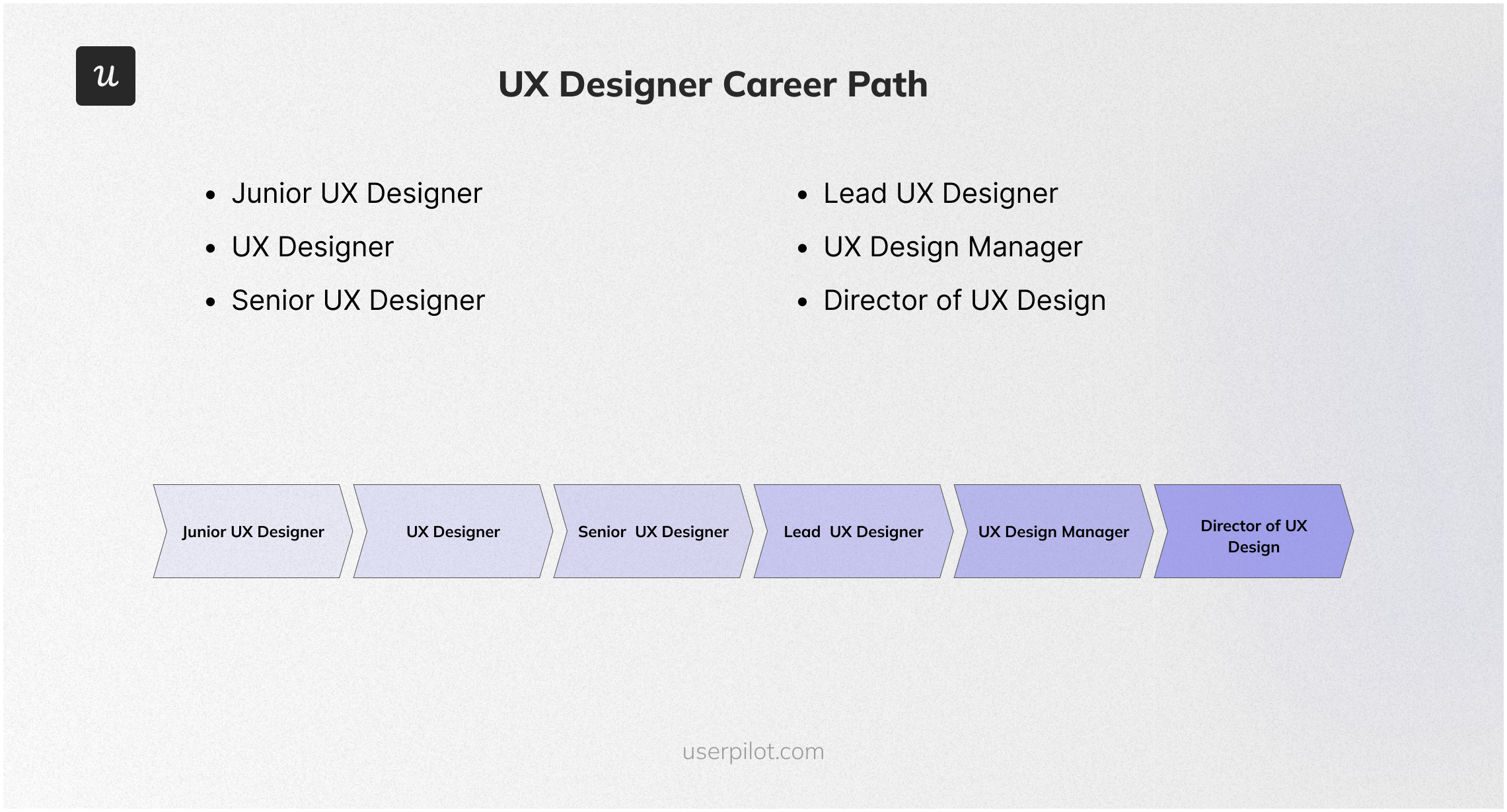
Try Userpilot Now
See Why 1,000+ Teams Choose Userpilot

What is a UX designer?
A UX designer, or user experience designer, focuses on enhancing user satisfaction by improving the usability, accessibility, and pleasure provided in the interaction between the user and the product.
In the SaaS industry, a UX Designer collaborates closely with product managers and developers to design intuitive interfaces that provide a seamless user experience, ultimately aiming to create products that are both functional and enjoyable to use.
What does a UX designer do?
A UX designer is responsible for creating user-friendly interfaces and enhancing user satisfaction by improving the usability, accessibility, and pleasure provided in the interaction between the user and the product.
They conduct user research, design wireframes, and prototypes, and perform usability testing to ensure that the product meets user needs.
UX designers collaborate closely with product managers, developers, and other stakeholders to create intuitive and effective user experiences, ultimately aiming to make the product functional, engaging, and enjoyable to use.
UX designer’s main responsibilities
A UX designer is essential in the SaaS industry for creating intuitive and engaging user experiences. Here are the main responsibilities and duties of a UX designer:
- Conduct User Research: Perform user research to understand user needs, behaviors, and pain points through methods such as interviews, surveys, and usability testing.
- Create Wireframes and Prototypes: Design wireframes, mockups, and interactive prototypes to visualize design solutions and gather feedback from users and stakeholders.
- Design User Interfaces: Develop visually appealing and user-friendly interfaces that enhance the overall user experience and align with the product’s functionality.
- Collaborate with Teams: Work closely with product managers, developers, and other stakeholders to ensure that design solutions align with business goals and technical constraints.
- Perform Usability Testing: Conduct usability testing to identify issues, gather user feedback, and iterate on designs to improve functionality and user satisfaction.
- Maintain Design Systems: Create and manage design systems and style guides to ensure consistency across all products and maintain a cohesive user experience.
- Stay Updated with Trends: Keep abreast of the latest design trends, tools, and technologies to bring innovative ideas and solutions to the team.
- Document Design Processes: Maintain clear and comprehensive documentation of design processes, decisions, and guidelines to ensure transparency and consistency within the team.
These responsibilities ensure that a UX designer effectively contributes to the creation of user-centric SaaS products that meet both user and business needs.
UX designer salary
The estimated total pay for a UI/UX designer in the United States ranges from $92,000 to $158,000 per year. This range includes both base pay and additional pay such as bonuses, commissions, tips, and profit sharing.
- Base Pay: The base salary typically ranges from $64,000 to $107,000 per year.
- Additional Pay: Additional compensation can range from $27,000 to $51,000 per year.
- Median Total Pay: The median total pay is estimated at approximately $119,592 per year, with an average base salary of $83,148 per year.
Furthermore, salaries can vary significantly depending on the company, with top companies like Cisco, Google, and Microsoft offering higher compensation packages. For example:
- Cisco: $215,675 per year.
- Google: $162,598 per year.
- Microsoft: $197,484 per year.
Jobs in arts & design, including UX design, are growing due to increased access to remote work. These roles often require a bachelor’s degree and technical skills such as graphic design software, web development, and research. Salaries can vary widely as jobs tend to be short-term and contractual, providing flexibility and the opportunity to manage multiple projects.

UX designer career path
A career in UX design involves progressing through various roles, each with increasing responsibility and expertise.
Here’s a typical career progression for a UX Designer:
- Junior UX Designer: Focuses on learning design tools, assisting senior designers, and supporting user research efforts. To progress, build a strong portfolio, seek feedback, and gain practical experience through internships or entry-level positions.
- UX Designer: Conducts user research, creates wireframes and prototypes, and collaborates with cross-functional teams. To advance, take on more complex projects, refine your skills, and develop a deeper understanding of UX principles and methodologies.
- Senior UX Designer: Leads major design projects, mentors junior designers, and plays a key role in strategic planning. To progress, enhance leadership skills, contribute to creating design systems, and build strong relationships with product managers and developers.
- Lead UX Designer: Oversees the design team, ensures design consistency, and aligns design goals with business objectives. Develop project management skills, drive innovation within the team, and engage in high-level strategic planning.
- UX Design Manager: Manages the UX design team, coordinates design efforts across projects, and ensures alignment with overall business strategy. Enhance managerial skills, stay updated with industry trends, and focus on optimizing team performance and design processes.
- Director of UX Design: Sets the overall design strategy for the organization, collaborates with top executives, and ensures the design vision aligns with the company’s mission. Focus on strategic leadership, expand influence across departments, and drive the company’s design innovation.
Each step in this career path builds on the previous one, emphasizing continuous learning, leadership, and strategic thinking to progress to higher levels of responsibility and influence in the field of UX design.
How to become a UX designer
To become a UX designer, start by obtaining a degree in design, human-computer interaction, psychology, or a related field.
Gain practical experience through internships at tech companies, design firms, or startups where you can work on real projects and build a strong portfolio.
Consider taking online courses or certifications in UX design to enhance your skills. Networking through industry events, joining professional organizations, and staying updated with the latest trends and tools in UX design will also boost your career prospects.
Best resources for UX designers
To excel in UX design, it’s important to continually learn and stay updated with the latest trends and best practices. Here are some top resources for UX designers, including books, webinars, podcasts, and blogs.
Best books for UX designers
Reading books by industry experts can provide deep insights and practical knowledge about UX design.
- “The Design of Everyday Things” by Don Norman – A classic book that explores the principles of good design and user experience.
- “Don’t Make Me Think” by Steve Krug – Focuses on web usability and intuitive design principles.
- “Lean UX” by Jeff Gothelf and Josh Seiden – Integrates UX with Agile methodologies for more collaborative and effective design processes.
- “Hooked: How to Build Habit-Forming Products” by Nir Eyal – Discusses the psychology behind user habits and how to create engaging products.
- “Inspired: How to Create Products Customers Love” by Marty Cagan – A guide on product management and creating products that resonate with users.
Best webinars for UX designers
Webinars offer real-time learning and insights from industry experts.
- Userpilot Webinars – Focus on user onboarding, engagement, and product growth.
- NNG (Nielsen Norman Group) Webinars – Expert insights on various UX topics, including usability and user research.
- Interaction Design Foundation Webinars – Cover a wide range of UX research and design principles.
- Baymard Institute Webinars – In-depth discussions on e-commerce usability and UX research.
- UX Design Institute Webinars – Detailed webinars on UX design principles and career development.
Best blogs for UX designers
Following blogs can help you stay updated on the latest trends, tips, and best practices in UX design.
- Userpilot Blog – Insights on user onboarding, product growth, and UX design.
- NNG (Nielsen Norman Group) Blog – Research-based articles on UX design and usability.
- Smashing Magazine – Covers a wide range of topics, including UX design, web development, and product management.
- UX Matters – Offers practical advice and insights on various UX research and design topics.
- UX Collective – Community-driven platform with articles on UX research, design, and industry trends.
These resources provide valuable knowledge and practical advice, helping you stay current and excel in your role as a UX Designer.
Best podcasts for UX designers
Listening to podcasts is a convenient way to stay informed and inspired by industry leaders while on the go.
- “User Defenders” – Interviews with UX design heroes sharing their stories and insights.
- “The UX Intern” – Conversations with UX professionals about their career paths and experiences.
- “UI Breakfast” – Discussions about UI/UX design, product strategy, and business with various experts.
- “What is Wrong with UX” – Experienced UX designers critique current trends and practices.
- “Awkward Silences” – Focuses on user research and customer experience insights.
Best tools for UX designers
Having the right tools is crucial for UX designers to enhance productivity, creativity, and collaboration.
Here are some of the best tools tailored for specific use cases:
- Best tool for User Onboarding and Engagement – Userpilot: Userpilot helps UX designers create personalized in-app experiences and smooth onboarding processes. It allows for real-time user feedback and insights to improve user engagement and retention.
- Best tool for Project Management – Monday: Monday.com offers a visual and flexible platform for managing projects and tasks. It’s ideal for UX designers to track project progress, collaborate with team members, and meet deadlines.
- Best tool for Product Management – Jira Software: Jira Software is perfect for tracking and managing design tasks, user stories, and sprints. It ensures seamless communication between designers and developers, facilitating efficient project workflows.
- Best tool for Customer Experience – Zendesk: Zendesk provides comprehensive customer support solutions. UX designers can use it to gather and analyze user feedback and support tickets, identifying areas for improvement in the user experience.
- Best tool for UX/UI Design – Figma: Figma supports real-time collaboration on design projects, making it ideal for creating wireframes, prototypes, and high-fidelity designs. It allows for easy sharing and feedback collection.
- Best tool for Documentation and Collaboration – Confluence: Confluence allows UX designers to create, share, and manage design documentation. It’s perfect for maintaining a centralized repository of design guidelines, research findings, and project documentation.
- Best tool for Customer Success – ClientSuccess: ClientSuccess helps monitor and analyze customer success metrics. UX designers can use it to understand user outcomes and iterate on designs to improve overall customer satisfaction.
- Best tool for Data Analytics – Tableau: Tableau offers powerful data visualization capabilities, allowing UX designers to analyze and present user research data in an intuitive and visually appealing way.
These tools collectively empower UX designers to conduct thorough research, manage projects effectively, collaborate with teams, and present data-driven insights that enhance user experience design.
Conclusion
We hope our article has given you a good overview of the career path for UX designers.
Whether you’re just starting out or looking to advance, the key is to stay curious, keep learning, and remain open to new opportunities along the way.
Looking into tools for UX designers? Userpilot is an all-in-one product platform with engagement features and powerful analytics capabilities. Book a demo to see it in action!









